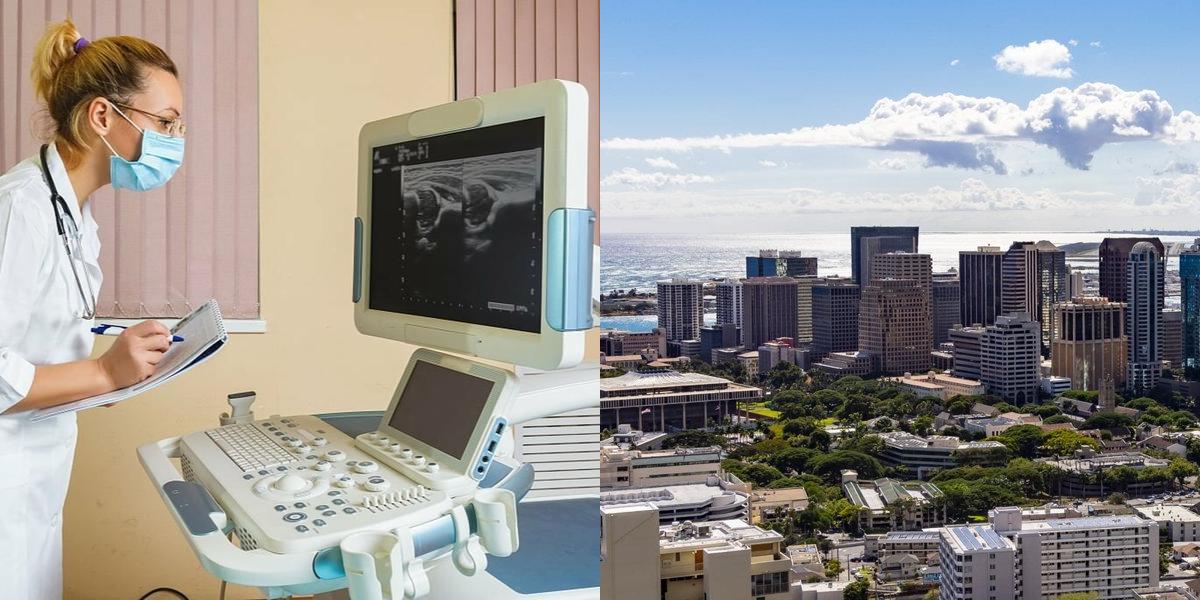How to Become a Medical Sonographer in Hawaii

Are you interested in a career in healthcare that involves using ultrasound technology to diagnose medical conditions? If so, becoming a medical sonographer may be the perfect career path for you. In this blog post, we will explore what a diagnostic medical sonographer does, where they work, the requirements to become one in Hawaii, and where you can find accredited sonographer schooling and sonographer programs in the state.
Key Points
- Diagnostic Medical Sonographers (also known as ultrasound technicians) create images of internal organs and tissues to assist in diagnosing medical conditions.
- To become a Diagnostic Medical Sonographer in Hawaii, you need to complete an accredited sonography program, obtain certification from organizations like ARDMS, and possibly acquire state licensure.
- In Hawaii, the average Diagnostic Medical Sonographer salary is $111,690 per year.
- Most programs take 2–4 years to complete, depending on the degree type.
How Do I Get My Diagnostic Medical Sonographer Certification?
To obtain your DMS certification, you will need to follow a few key steps:
1. Complete an accredited program: Begin by enrolling in an accredited program in diagnostic medical sonography at a community college, vocational school, or university. These programs provide comprehensive training in various areas such as abdominal, obstetric, gynecologic, vascular, and cardiac sonography. Look for programs accredited by the Commission on Accreditation of Allied Health Education Programs (CAAHEP) or the Joint Review Committee on Education in Diagnostic Medical Sonography (JRC-DMS). During your program, you'll receive classroom instruction and hands-on clinical experience to prepare you for your career.
2. Gain clinical experience: After completing your accredited program, gain clinical experience through internships or clinical rotations. This hands-on experience allows you to work directly with patients under the supervision of experienced sonographers. You'll perform ultrasound examinations, assist in interpreting results, and refine your technical skills in a healthcare setting.
3. Pass the certification exams: Once you've completed your education and gained sufficient clinical experience, you're eligible to take the certification exams. The American Registry for Diagnostic Medical Sonography (ARDMS) and the American Registry of Radiologic Technologists (ARRT) offer certification exams such as RDMS, RDCS, RVT (ARDMS), and Sonography (S) (ARRT). Prepare for these exams by reviewing content outlines and utilizing study materials such as textbooks and practice exams to ensure you're well-prepared.
4. Maintain certification: After passing the certification exams and obtaining your DMS certification, maintain your certification by fulfilling continuing education requirements. This involves earning a specified number of continuing education credits over a defined period. Continuing education ensures you stay current with advancements in sonography and demonstrates your commitment to professional growth and providing high-quality patient care.
How Do I Get a Job as a Diagnostic Medical Sonographer?
Once you have obtained your Diagnostic Medical Sonographer (DMS) certification, you will be ready to embark on a rewarding career in the field of sonography. Here are some steps you can take to increase your chances of finding a job as a DMS:
1. Update your resume: Before applying for jobs, update your resume to highlight your education, clinical experience, and DMS certification. Include details of relevant coursework, clinical rotations, and any specialized skills or qualifications you've acquired during your training. Tailor your resume to emphasize your proficiency with ultrasound equipment and knowledge of diagnostic procedures.
2. Network: Networking is essential in finding job opportunities as a DMS. Reach out to your instructors, classmates, and clinical supervisors from your accredited program to let them know you're actively seeking employment. Professional organizations like the Society of Diagnostic Medical Sonography (SDMS) and the American Institute of Ultrasound in Medicine (AIUM) offer networking events and resources that can connect you with potential employers and industry professionals.
3. Search for job openings: Utilize online job boards to search for DMS positions in your desired location. Visit the websites of local hospitals, medical centers, and imaging facilities to explore their career pages for job listings. Consider contacting healthcare facilities directly to inquire about potential openings that may not be advertised publicly.
4. Prepare for interviews: As you receive interview offers, prepare thoroughly to impress potential employers. Research each facility to understand their services and values. Practice answering common interview questions that highlight your clinical experience, teamwork skills, attention to detail, and commitment to patient care. Be ready to discuss specific cases or procedures you've encountered during your clinical rotations to demonstrate your expertise.
5. Continuing education and professional development: Once hired as a DMS, prioritize continuing education to stay current with advancements in sonography. Attend conferences, workshops, and webinars to expand your knowledge and skills. Consider pursuing additional certifications or specializations to enhance your professional credentials and open doors to career advancement opportunities. Continuing education shows your dedication to professional growth and ensures you provide the highest quality of care to patients.
Career Outlook and Salary for Diagnostic Medical Sonographers in Hawaii
Here are some of the career paths and opportunities available to DMS professionals:
-
General Sonographer: Many DMS professionals work as general sonographers, performing a variety of ultrasound examinations on different parts of the body. These examinations may include abdominal, pelvic, obstetric, gynecologic, and small parts ultrasound. General sonographers are often employed in hospitals, medical centers, imaging centers, and private practices.
-
Obstetric and Gynecologic Sonographer: Obstetric and gynecologic sonographers specialize in performing ultrasound examinations on pregnant women and female reproductive organs. They play a critical role in monitoring the health and development of the fetus during pregnancy and assisting in the diagnosis of gynecologic conditions. Obstetric and gynecologic sonographers are often employed in hospitals, women's health clinics, and fertility centers.
-
Vascular Sonographer: Vascular sonographers specialize in performing ultrasound examinations on the blood vessels to evaluate blood flow and detect any abnormalities or blockages. They play a crucial role in diagnosing and monitoring vascular conditions, such as deep vein thrombosis, peripheral artery disease, and carotid artery stenosis. Vascular sonographers are often employed in hospitals, vascular laboratories, and cardiovascular clinics.
-
Cardiac Sonographer: Cardiac sonographers specialize in performing ultrasound examinations on the heart to evaluate its structure and function. They play a vital role in diagnosing and monitoring various cardiac conditions, such as heart valve abnormalities, congenital heart defects, and heart disease. Cardiac sonographers are often employed in hospitals, cardiac catheterization laboratories, and echocardiography clinics.
-
Education and Research: Some DMS professionals choose to pursue careers in education and research. They may work as instructors in diagnostic medical sonography programs, teaching aspiring sonographers the skills and knowledge required for the profession. Others may work in research settings, conducting studies and contributing to the advancement of medical imaging technology and techniques.
-
Management and Administration: With experience and further education, DMS professionals can also pursue careers in management and administration. They may take on roles such as department managers, supervisors, or directors, overseeing the operations of ultrasound departments and ensuring the delivery of high-quality patient care.
-
Entrepreneurship: Some DMS professionals choose to start their own ultrasound imaging businesses. They may establish their own private practices or mobile ultrasound services, providing imaging services to healthcare facilities or directly to patients. Entrepreneurship allows DMS professionals to have more control over their work schedule, patient interactions, and business operations.
Frequently Asked Questions
How much does a medical sonographer earn in Hawaii?
As of May 2023, the average annual salary for medical sonographers in Hawaii is $111,690, according to data from the Bureau of Labor Statistics (BLS). Salaries can vary based on factors such as experience, location within the state, and the specific healthcare facility where one is employed.
What state pays sonographers most?
California is the highest-paying state for medical sonographers as of May 2023, with an average annual salary of $122,670. Following California are Hawaii with $111,690, Oregon with $104,260, Massachusetts with $101,420, and Connecticut with $99,610. These figures reflect regional differences in cost of living and demand for healthcare services.
What is the highest paid medical sonographer?
The highest-paid medical sonographers often work in states with higher costs of living and strong demand for healthcare services, such as California, Hawaii, and Oregon. Specializing in certain areas of sonography, such as cardiac or vascular sonography, can also contribute to higher earnings due to specialized skills and certifications.
How long does it take to become a sonographer?
Becoming a medical sonographer typically requires completing an accredited program, which can take about 2 to 4 years depending on the program and whether one pursues an associate's or bachelor's degree. After graduation, passing a national certification exam is necessary to become a registered diagnostic medical sonographer (RDMS), leading to state licensure in some areas.
What do you need to become a sonographer?
To become a medical sonographer, one needs to complete an accredited program in diagnostic medical sonography, which includes both classroom instruction and clinical training. After graduation, passing a certification exam from organizations like the American Registry for Diagnostic Medical Sonography (ARDMS) is required. State licensure may also be necessary depending on where you plan to practice, ensuring that sonographers meet professional standards for patient care and safety.
Final Thoughts
Becoming a Diagnostic Medical Sonographer in Hawaii offers a rewarding career with competitive salaries and high demand. By completing an accredited program and obtaining certification, you can step into a growing field that combines healthcare and advanced technology.
Ready to start your journey? Explore training programs on Dreambound and find the right fit for your career goals today!
Are you thinking about a job change or wanting to learn more about different career paths? Feel free to check out these additional articles:

Athena is Co-founder and CEO of Dreambound.




